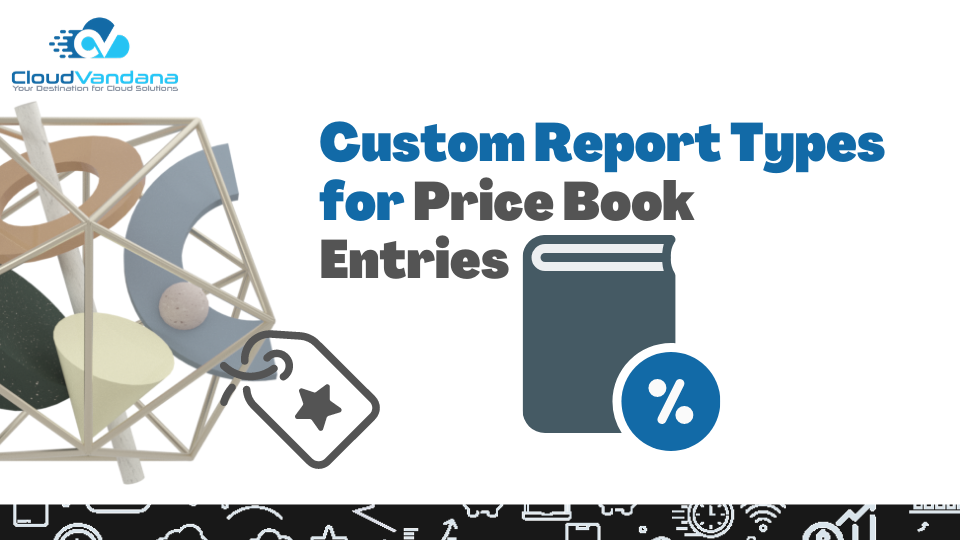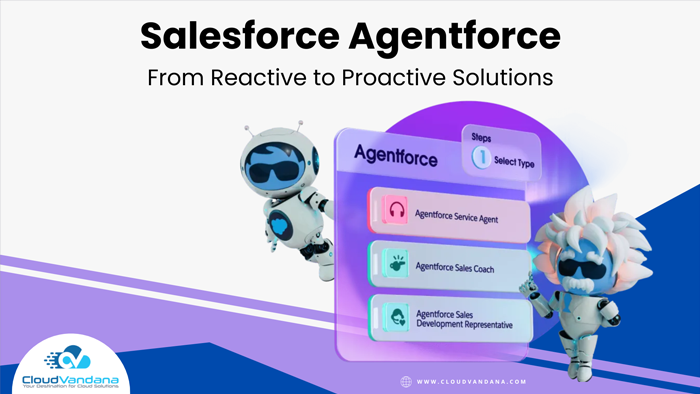Unlock advanced pricing visibility in Salesforce with Custom Report Types for Price Book Entries. Learn how to build, configure, and scale pricing intelligence reports with expert insights from CloudVandana.
Despite playing a pivotal role in Salesforce’s product and pricing architecture, Price Book Entries remain one of the most underutilized objects when it comes to reporting. Many teams focus on Opportunity or Product-based reports, ignoring the nuanced pricing strategy hidden within Price Books. This oversight creates blind spots in profitability analysis, pricing governance, and go-to-market alignment.
The Strategic Importance of Reporting on Price Books Entries
Price Books are not just static catalogs—they’re dynamic business tools. They define regional pricing, tiered discounts, and strategic segmentation. Without visibility into Price Book Entry data, organizations miss critical opportunities to analyze pricing consistency, detect anomalies, and drive margin intelligence.
Understanding Price Book Entries
What Are Price Book Entries?
In Salesforce, a Price Book Entry represents the association between a product and its price within a specific Price Book. It’s a junction object connecting the Product2 and PriceBook objects, storing the list price and activation status.
Relationship Between Products, Price Books, and Opportunities
Products live in Product2. Price Books house collections of these products at defined prices. Opportunities pull from Price Books to add products to deals. This chain of relationships means any error or omission at the Price Book Entry level can ripple through forecasts, revenue recognition, and customer expectations.
Native Reporting Limitations in Salesforce
What Standard Reports Miss
Out of the box, Salesforce does not offer a report type that lets users directly analyze the Price Book Entry object. You can report on Products, Opportunities, and Opportunities with Products—but the linkage to list price data across Price Books is absent.

When Built-In Product Reports Fall Short
A standard “Products” report can tell you which products are selling, but not how pricing differs across regions or price books. It won’t flag missing entries, inactive products, or inconsistent list prices—gaps that can lead to revenue leakage or compliance issues.
The Power of Custom Report Types (CRTs)
What Is a Custom Report Type?
Custom Report Types in Salesforce allow you to define report data models beyond what’s available by default. They give you control over which objects to include, how they’re joined, and which fields are exposed to the reporting engine.
Benefits of Using CRTs for Price Book Entry Data
With CRTs, you gain granular visibility into pricing architecture. You can analyze which products appear in which price books, detect anomalies in list prices, and enforce pricing compliance across geographies or customer segments.
Planning Your Custom Report Type Strategy
Define the Business Use Case
Before building anything, define your objective. Do you need to identify gaps in price book coverage? Validate pricing tiers? Measure product availability across partner catalogs? Anchoring your CRT in a use case ensures relevance and adoption.
Identify the Reporting Audience and Purpose
Sales ops? Pricing managers? Legal and compliance? Each stakeholder has unique needs. Understanding the audience helps determine the level of field detail, visibility controls, and UI complexity required.
Object Relationships for Price Book Entries
Understanding the Schema: Price Book Entry Object
The Price Book Entry (API name: PricebookEntry) is a junction object linking Product2 and Pricebook2. Key fields include:
- Product ID (lookup to Product2)
- Price Book ID (lookup to Pricebook2)
- Unit Price (list price)
- UseStandardPrice (boolean)
- IsActive (boolean)
Key Fields to Include in Your CRT
Include fields that capture pricing insights: list price, active status, standard price usage, currency, product family, and price book name. This ensures your report supports both operational analysis and strategic review.
Creating a Custom Report Type
Step-by-Step Instructions
- Navigate to Setup > Report Types
- Click “New Custom Report Type”
- Select Price Book Entry as the primary object
- Add related objects (e.g., Product2, Pricebook2)
- Define report name, category, and deployment status
- Save and proceed to edit field layout
Choosing the Right Primary Object
Starting with Price Book Entry as the primary object is crucial. This allows you to surface each product-price book pair and layer on joined data from related records.
Sample CRT Configuration for Price Book Entries
Base Object: Price Book Entry
This surfaces the junction data—unit price, active status, and product reference.
Joined Object: Product2
Allows inclusion of product name, product code, product family, and custom product fields.
Joined Object: Price Book
Enables filtering and grouping by price book name, region, or pricing tier.
Optional: Opportunity Line Items
If needed, join to Opportunity Products to analyze how entries are used in real deals, enabling coverage vs. usage analysis.
Use Cases for Reporting on Price Book Entries
Tracking Product Pricing Across Price Books
Identify discrepancies in list prices between Global, Partner, and Channel price books. Spot gaps that may lead to negotiation delays or misquoting.
Identifying Products Missing in Certain Price Books
Run an anti-join style analysis to detect which products are missing from critical price books—vital for partner enablement and catalog completeness.
Audit and Compliance Reporting
Verify that inactive products are removed from active price books, or that products using standard price are correctly flagged for audit readiness.
Adding Fields via Field Layouts
Tailoring the Report Layout
Customize the report type layout to include only relevant fields. Group them logically—pricing, product details, and metadata—for ease of use by business teams.
Including Custom Fields and Lookup Values
Expose custom fields such as cost price, margin tier, or SKU type. Include lookup fields to product managers or pricing approvers if needed for workflow traceability.
Building Reports from the CRT
Selecting the Custom Report Type in Report Builder
In the report builder, choose your new CRT and start from a blank report. Apply filters like “IsActive = True” or “Pricebook Name = ‘APAC Pricing’” to isolate actionable records.
Filtering, Grouping, and Summarizing Price Book Data
Group by Price Book, then by Product Family. Summarize list prices, count entries, or use row-level formulas to compare prices across tiers or geographies.
Real-World Example: Multi-Region Pricing Oversight
Scenario Setup
An organization operates three regional price books: North America, Europe, and Asia. They need to validate pricing alignment across all three to maintain a global pricing strategy.
Insights Gained
Using a CRT, they identify a 15% price gap for high-margin products between regions. The report also flags 12 products missing from the APAC price book, triggering urgent catalog updates before a product launch.
Advanced Reporting Scenarios
Cross-Object Filtering: Products by Account Segments
Using joined filters, you can report on Price Book Entries associated with opportunities from enterprise accounts only—giving pricing teams better segmentation analysis.
Variance Analysis on List Prices
Create row-level formulas to calculate price deltas between price books. Visualize discrepancies to support re-pricing initiatives or tier redesign.
Challenges and Workarounds
Price Book Entry Doesn’t Support Report Subscriptions
Salesforce does not allow direct report subscriptions for some CRTs. This limits automation for weekly price audits.
Workaround Using Joined Reports or Dashboards
Use dashboards with joined reports or schedule report exports via a Flow + Report export app. Alternatively, create a custom object to replicate key metrics for automation.
Integration with CPQ and Revenue Cloud
When Price Book Entries Feed Into CPQ Logic
In Salesforce CPQ environments, price book entries influence price rules, product bundles, and approval thresholds. Reporting on them is essential for validating CPQ configurations.
Reporting for Pricing Strategy Alignment
Pricing managers use CRTs to ensure the CPQ pricing logic is reflected accurately in the price book architecture, eliminating configuration mismatches.
Field-Level Security and Report Visibility
Ensuring Proper Access to Pricing Data
Always confirm that users generating reports have access to fields like Unit Price or Custom Pricing Tiers. Misconfigured profiles can lead to broken reports or incomplete data.
Managing Sensitive Fields in Shared Reports
Avoid exposing cost price or margin calculations to users without clearance. Use report folders with strict access and audit usage regularly.
Maintaining CRTs Over Time
Version Control and Naming Conventions
Use a structured naming format: “PBE_ReportType_v1.1” and document schema versions. This avoids confusion during enhancements or post-deployment audits.
Auditing Field Changes and Dependencies
Whenever field-level changes occur on Product2 or Price Book Entry, validate the CRT and associated reports to avoid breaking dependencies.
Governance and Documentation
Documenting Use Cases and Logic
Each CRT should have documentation outlining purpose, filters, logic, and stakeholders. Store it in your Salesforce governance repository or Confluence.
Establishing Report Ownership
Assign report owners for each mission-critical CRT. This ensures someone is responsible for upkeep, performance checks, and business relevance reviews.
Tools to Accelerate CRT Development
Schema Builder
Use Schema Builder to visualize object relationships before designing your CRT. This helps clarify which lookups or custom fields to include.
Third-Party Visual Modelers
Third-party tools can help map report logic, build governance workflows, and align with your data model documentation.
Conclusion
Custom Report Types for Price Book Entries are no longer a luxury—they’re a necessity for companies aiming to control pricing strategy, product catalog integrity, and revenue operations within Salesforce. But the complexity of object relationships, permissions, and data logic requires more than just knowledge of the platform—it demands strategic implementation with precision.
At CloudVandana, we specialize in crafting intelligent, scalable Salesforce solutions that elevate reporting to a business enabler. Whether you’re managing complex price books across multiple regions, aligning CPQ configurations with product data, or designing audit-proof pricing intelligence, our team ensures your reports deliver clarity and control. We help you unlock the hidden value of your data through thoughtful report design, robust governance, and aligned stakeholder strategy.
Ready to simplify pricing visibility and transform your Salesforce reporting stack?











0 Responses
Thank you for sharing your thoughts. I really appreciate your efforts and I am waiting for
your further write ups thank you once again.